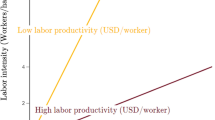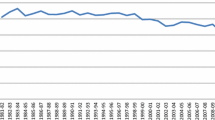Abstract
Agricultural production in most African countries is characterized by labor-intensive but low-input, low-output production systems compared to capital-intensive, profit-driven mechanized production systems in developed countries. It thus follows that when considering the labor impacts of GM crops it is important to distinguish between farmers in developed countries using mechanized production systems and farmers in developing countries where agriculture is generally the sole source of livelihood and employment. Adoption of GM agricultural technologies can result in substantial laboursaving for farmers and in a production systems where labor is a limiting factor, increased labor productivity might result in production expansion and additional employment opportunities over the longer term. However, in the short term and in absence of mitigating strategies, laboursaving technologies can impact negatively on the rural poor who sell their labor.
Access this chapter
Tax calculation will be finalised at checkout
Purchases are for personal use only
Similar content being viewed by others
References
Akobundu OI (1987) Weed science in the tropics: principles and practices. Wiley-Interscience, Chichester
Brookes G, Barfoot P (2011) GM crops: global socio-economic and environmental impacts 1996–2009. PG Economics Ltd, UK
Carpenter J, Gianessi L (1999) Herbicide tolerant soybeans: why growers are adopting roundup ready varieties. AgBioForum 2(2):65–72
Carpenter J, Gianessi L (2000) Herbicide use on roundup ready crops. Science 4:203
Carpenter J, Gianessi L (2002) Agricultural biotechnology: updated benefit estimates. National Centre for Food & Agriculture Policy, Washington, DC
Chikoye D, Udensi EU, Fontem Lum A et al (2007) Rimsulfuron for post emergence weed control in corn in humid tropical environments of Nigeria. Weed Technol 21:977–981
De Janvry A, Sadoulet E (2010) Agriculture for development in africa: business-as-usual or new departures? J Afr Econ 19(2):7–39
FAO (2011) The state of food and agriculture. Woman in agriculture, closing the gap for development. Rome, Italy
FAO/UNIDO (2008) Agricultural mechanization in Africa…Time for action. Planning investment for enhanced agricultural productivity, Report of an Expert Meeting, January, Vienna, Austria
Fernandez-Cornejo J, Hendricks C, Mishra A (2005) Technology adoption and off-farm household income: the case of herbicide-tolerant soybeans. J Agr Appl Econ 37:549–563
Fernandez-Cornejo J, Klotz-Ingram C, Jans S (2002) Farmlevel effects of adopting herbicide-tolerant soybeans in the USA. J Agr Appl Econ 34(1):149–163
Finger R, El Benni N, Kaphengst T et al (2011) A meta-analysis on farm-level costs and benefits of GM crops. Sustainability 3(5):743–762
Gardner JG, Nehring RF, Nelson CH (2009) Genetically modified crops and household labor savings in US crop production. AgBioForum 12(3, 4):303–312
Gianessi L (2009) Solving africa’s weed problem: increasing crop production and improving the lives of women. Crop Protection Research Institute
Gomez-Barbero M, Rodriguez-Cerezo E (2006) The adoption of GM insect-resistant Bt maize in spain: an empirical approach, 10th ICABR conference on agricultural biotechnology, July, Ravello, Italy
Gouse M (2009) Ten years of Bt cotton in South Africa: putting the smallholder experience into context. In: Tripp R (ed) Biotechnology and agricultural development: transgenic cotton, Rural Institutions and Resource-Poor Farmers. Routledge, Abingdon Oxford
Gouse M (2012) Farm-level and socio-economic impacts of a genetically modified subsistence crop: the case of smallholder farmers in KwaZulu-Natal, South Africa. Submitted in partial fulfilment of the requirements for the degree PhD in Department Agricultural Economics, Extension and Rural Development, University of Pretoria
Gouse M, Pray C, Schimmelpfennig D (2005) The distribution and benefits from Bt cotton adoption in South Africa. AgBioForum 7(4):187–194
Hurley TM, Mitchell PD, Frisvold GB (2009) Effects of weed resistance concerns and resistance management practices on the value of roundup ready crops. AgBioForum 12:291–302
Ishaya DB, Dadari SA, Shebayan JAY (2007a) Evaluation of herbicides for weed control in sorghum (Sorghum bicolour) in Nigeria. Crop Prot 26:1697–1701
Ishaya DB, Dadari SA, Shebayan JAY (2007b) Evaluation of herbicides for weed control in three varieties of upland rice (oryza sativa L.) in the Nigerian Savannah. Crop Prot 26:1490–1495
Kent RJ, Johnson DE, Becker M (2001) The influences of cropping system on weed communities of rice in Côte d’Ivoire, West Africa. Agr Ecosyst Environ 87(3):299–307
Kibata GN, Maina JM, Thuranira EG et al (2002) Participatory development of weed management strategies in maize based cropping systems in Kenya. Thirteenth Australian Weeds Conference Proceedings 343–344
Marais JN (1992) FSR-E Newsletter No. 4, November 1992. Southern African Association for Farming Systems Research-Extension, Development Bank of Southern Africa, Halfway House, South Africa
Marra MC, Piggott NE, Carlson GA (2004) The net benefits, including convenience, of roundup ready® soybeans: results from a national survey (Technical Bulletin 2004–3). NSF Centre for IPM, Raleigh
Mavudzi Z, Mashingaidze AB, Chivinge OA et al (2001) Improving weed management in a cotton-maize system in the Zambezi Valley Zimbabwe. Brighton Crop Protection Conference, Weeds 169–174
Pingali PL (2007) Agricultural mechanization: adoption patterns and economic impact. In: Evenson R, Pingali P (eds) Handbook of agricultural economics, Volume 3. Elsevier, Amsterdam
Pingali PL, Bigot Y, Binswanger H (1987) Agricultural mechanization and the evolution of farming systems in Sub-Saharan Africa. The World Bank, Washington DC
Pray C, Huang J, Hu R et al (2002) Five years of Bt cotton in China—the benefits continue. Plant J 34:423–430
Qaim M, Traxler G (2005) Roundup ready soybeans in Argentina: farm level and aggregate welfare effects. Agr Econ 32:73–86
Smale M, Zambrano P, Gruère G et al (2009) Measuring the economic impacts of transgenic crops in developing agriculture during the first decade: approaches, findings, and future directions. Food Policy Review 10, International Food Policy Research Institute (IFPRI)
Subramanian A, Qaim M (2009) Village-wide effects of agricultural biotechnology: the case of Bt Cotton in India. World Dev 37(1):256–267
Trigo EJ (2011) Fifteen years of genetically modified crops in Argentinian agriculture. Argentine Council for Information and Development of Biotechnology—ArgenBio
Tsikata D (2009) Informalization, the Informal Economy and Urban Women’s Livelihoods in Sub-Saharan Africa since the 1990s. In: Razavi S (ed) The gendered impacts of liberalization: towards “Embedded Liberalism? Routledge, New York
UNEP GEO Data Portal (2006). Accessed June 2012
UNIFEM (2010) Women’s land and property rights. UN Woman, September 9. http://www.unifem.org/gender_issues/women_poverty_economics/land_property_rights.php. Accessed 27 Nov 2012
Vitale JD, Vognan G, Ouattarra M et al (2010) The commercial application of GMO crops in Africa: Burkina Faso’s decade of experience with Bt cotton. AgBioForum 13(4):320–332
White DR, Burton ML, Dow MM (1981) Sexual division of labour in African agriculture: a network autocorrelation analysis. American Anthropological Association, Vol 83
World Bank (2009) African development indicators 2008/2009. Youth and employment in Africa. The potential the problem the promise. Washington DC
World Resource Institute (2000) via Nationmaster.com. Accessed 19 June 2012
Yorobe JM, Smale M (2012) Impacts of Bt maize on smallholder income in the Philippines. AgBioForum 15(2):152–162
Author information
Authors and Affiliations
Corresponding author
Editor information
Editors and Affiliations
Rights and permissions
Copyright information
© 2014 Springer Science+Business Media, LLC
About this chapter
Cite this chapter
Gouse, M. (2014). Labor Impacts. In: Ludlow, K., Smyth, S., Falck-Zepeda, J. (eds) Socio-Economic Considerations in Biotechnology Regulation. Natural Resource Management and Policy, vol 37. Springer, New York, NY. https://doi.org/10.1007/978-1-4614-9440-9_13
Download citation
DOI: https://doi.org/10.1007/978-1-4614-9440-9_13
Published:
Publisher Name: Springer, New York, NY
Print ISBN: 978-1-4614-9439-3
Online ISBN: 978-1-4614-9440-9
eBook Packages: Business and EconomicsEconomics and Finance (R0)




